Robert Hamilton Watts
The following has been written with assistance and information from Jean Thomas (nee Mason), Robert's fiancee, and her son Rob Thomas.
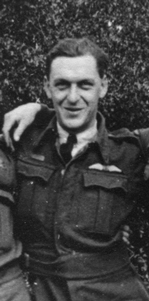
At 17:26 hours on October 20th 1943, F/Sgt Robert Hamilton Watts and his crew lifted off from RAF Dunholme Lodge into the scattered low clouds for their 8th operational sortie, part of a force of 358 Lancasters bound for Leipzig. Their aircraft, EE184, coded KM-B, which they had been allocated on arrival at the squadron, was one of 15 aircraft fielded for the operation by 44 Squadron. This was Bomber Command's first major attack on the city. Some three and a half hours after takeoff, they were able to identify their target from marker flares dropped by the pathfinder aircraft assigned to the raid. Bombs were dropped at 2106 hours, and F/Sgt Watts turned onto the course passed by his navigator, Sgt John Connor, and headed for Dunholme, his temporary home during since his crew were posted on to 44 Squadron in August. Everything seemed in order, flak was not as heavy as usual, no nightfighters around, although Sgt Holly Young and Sgt Pete Dennis, the crew's gunners kept their usual hawk-like lookout for the first sign of anything unusual that might herald an attack on the bomber stream. Sgt Bob Hogg the bomb aimer continued to push out bundles of radar-reflective strips known as 'Window' to mask the aircraft's location on German radar.
As the aircraft made its way to and from the target area, Sgt Don Pierce the flight engineer kept logs of fuel consumption at regular intervals. When the main tanks in the wings registered 80 gallons each left in them, he turned the fuel cocks to feed the engines from the centre tanks. Almost immediately both starboard engines began to splutter and cut out. Quickly, the flight engineer realised that the fuel feed line from the starboard centre tank had probably been severed by flak damage and when the cock was opened on the tank, the fuel was just venting into the sky. He changed the fuel feed for the starboard engines to the port tanks, running the engines from them until each tank in turn ran dry. The port engines then cut out and could not be restarted. This presented yet another problem for the crew - the port outer engine drove the alternator required to supply electrical power to the aircraft. He took the decision to allow the port outer propellor to periodically 'windmill' - running free in the slipstream to keep the engine turning over and generating electricity at the expense of extra drag induced by the blades. This allowed Sgt Connor to get accurate position fixes. The aircraft was at 16000 feet over the North Sea when the port engines cut, and began to lose height rapidly. It was not a pleasant night at sea-level, a heavy swell was running in the brisk south-westerly wind. F/Sgt Watts warned the crew over the intercom that ditching was a very real possibility. Sgt Connor kept taking regular position fixes using the Gee equipment, and the wireless operator Sgt Jock Gilmour passed them on to the monitoring station at Heston.
When the aircraft reached 2000ft, the flight engineer helped F/Sgt Watts to remove his parachute pack, tightened his harness straps and partially inflated his Mae West lifejacket. He then removed the front escape hatch, and moved back to behind the aircraft's rear spar to assume his ditching position. About two minutes later F/Sgt Watts, alone in the front of the aircraft, turned the Lancaster almost into the wind and touched down on the water approximately 5 miles south of the Humber lightship, just off the north Lincolnshire coast. The choppy seas made for a rough ditching, the Lancaster broke its back just aft of the mid-upper turret and the tail section sank immediately. The dinghy was released from the starboard wing and inflated automatically. The crew clambered out of the top escape hatch and crawled along the wing, boarding the dinghy. Sgt Connor became aware that F/Sgt Watts had not appeared from the cockpit and went to the leading edge of the wing. Shortly afterwards, he either dived off or was knocked off the wing, and disappeared into the dark water. The rest of the crew paddled the dinghy round to the front of the aircraft, blowing their survival whistles to give him something to swim towards, but in the heavy seas and darkness they were unable to find him.
After some time, the five in the dinghy began to be violently seasick. They knew that they were relatively close to the Lincolnshire coast, and that it would not be too long until dawn broke. They decided to put out the dinghy's sea anchor to keep them pointed into the wind so as to minimise the effects of the sea on them. Having sent out a final position signal just before they ditched, they were confident that rescue vessels would be nearby soon. Some lights were seen, which the crew believed to be the coast, so they fired a Verey flare to attract attention. Not long afterwards, a large cargo ship passed within 100 yeards of the dinghy, but did not spot it in the dark. Almost immediately, another ship with a searchlight was seen, this time, they were successful in attracting attention. After 3 hours and 10 minutes in their dinghy, the five survivors were hauled aboard the minesweeper HMS Loch Moidart. They were taken back to Grimsby suffering from cold and shock, and spent the remainder of the night at the naval hospital there under observation before being discharged and returned to Dunholme Lodge. Bomber Command lost 16 Lancasters from the attacking force this night, an unusually high 4.5% loss rate.
Sgt Connor's body was never found, he is commemorated on the Runnymede Memorial. Some weeks after the incident, F/Sgt Watts' body washed up on the Dutch coast, and was taken to Bergen-Op-Zoom for identification. After the German authorities notified the International Red Cross of the discovery of his body, F/Sgt Watts was buried locally. After the war ended, Robert's body was moved to the CWGC Bergen-Op-Zoom Canadian cemetery.
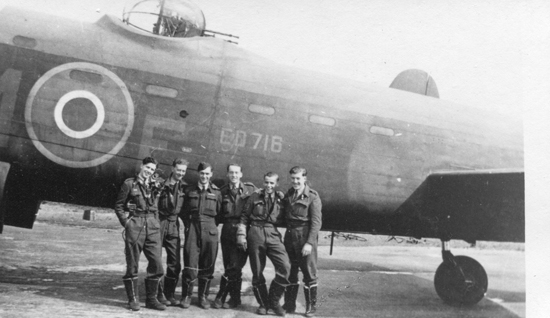
Six of Robert Watts' crew posing by Lancaster ED716 KM-E after a training flight, September 1943.
Born in Adelaide, South Australia in 1920, Robert was one of 4 brothers born to Raymond & Dorothy Watts. After leaving school, Robert went to work for the Commonwealth Bank in Adelaide. Whilst working here a friend introduced him to Jean deRose Martin who worked at National Mutual in the city, Their relationship prospered and in 1940 they became engaged. Jean has fond memories of listening to classical music on her Columbia gramophone with Robert.
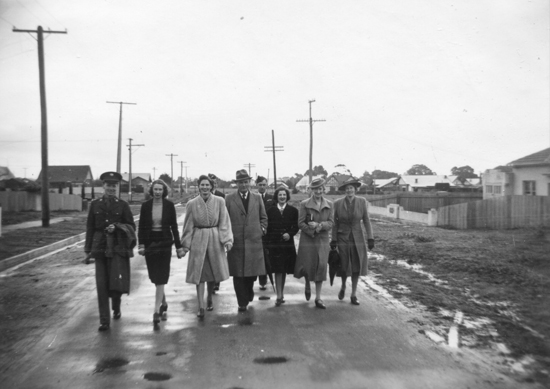
Robert and Jean with family and friends, Adelaide, 1942
Jean Thomas (central figure white coat) walking with her father on her right (photo right), mother (further right) and Robert Watts (fourth from right at the back).
By late 1943, three of the people in this photo had been killed in action: King Marsh (a family friend) on the very left, Mary McFarlane (third from right) and Robert.
Mary (a nurse) was lost when the Centaur was torpedoed by the Japanese off Brisbane, there is no record of how King Marsh was killed and, Robert Watts was killed when his Lancaster ditched.
On August 29th that year, Robert enlisted as an airman with the Royal Australian Air Force. He was selected for pilot training, and his early service career saw him training at Adelaide, Victor Harbor, Tamworth, Sydney, and Point Cook. He completed initial flying training and was awarded his wings at Point Cook on 23rd June 1941. On the same day was registered as trainee aircrew. Early in 1942, he embarked on a troopship for overseas deployment at Sydney and spent some time training in South Africa on his way to the UK. He disembarked in the UK on the 18th of November 1942. After a period of administration, Robert was posted to a Pilot Advanced Flying Unit (PAFU) for training on multi-engined aircraft.
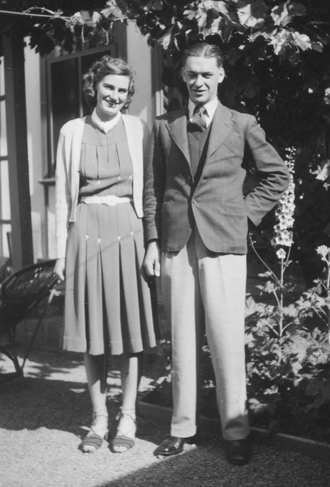
Robert and Jean photographed in 1940
in the backyard of Jean's home at Eynesbury Avenue, Kingswood, Adelaide.
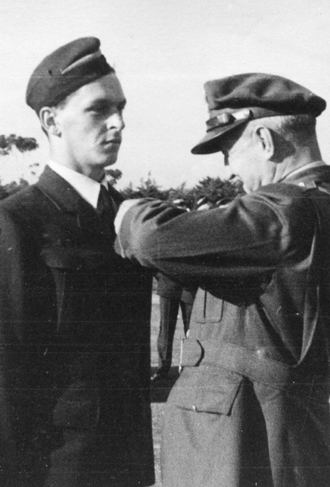
Robert Watts receiving his "Wings" at Point Cook in 1941.
Following successful completion of the (P)AFU course, he would have been posted to an Operational Training Unit (OTU) where he'd have met up with most of his crew and learned to work as captain of the aircraft and leader of the crew. At least one of the gunners would have joined the crew after the OTU stage was completed, but before, or just as, the crew progressed to 1661 Conversion Unit, where they'd be taught to fly and fight a 4-engined heavy bomber. Robert and his crew were posted from 1661CU to 44Sqn on 21st August 1943. The gap between joining 44 and his first Op on 22nd September would have been filled with training from experienced crewmembers and a series of flights to ensure they stood a good chance of survival on their first few ops. The crew flew 7 sorties in close succession - 22nd & 23rd September, and abortive trip on the 27th September, 1st, 2nd, 4th & 7th October, then had a period of 11 days where they weren't posted on ops - this may have been occupied by leave or other non-operational flights not listed in the Squadron records. Their fateful trip on 20/21st was their first op after this rest period. F/Sgt Watts' promotion to P/O was approved on 20th October 1943, but had not been passed on the the Squadron by the time of his death. A few months after Robert's death his younger brother Keith was killed in a flying accident off Gibraltar on 12th February 1945.
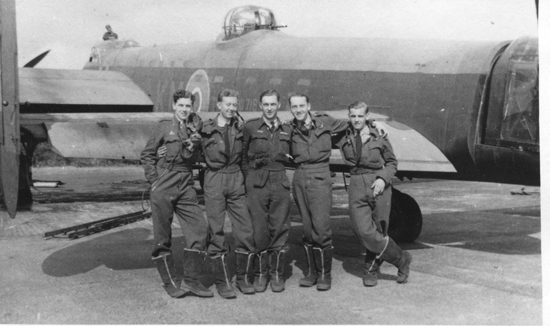
Robert watts and four of his crew standing by a 44 Squadron Lancaster after a training flight, September 1943.
The operational sorties flown by Robert and his crew were:
22/9/43
Hanover
Lancaster EE184 KM-B
Took off at 19:14hrs
Bombed the target from 19,500ft at 21:04hrs
Landed at 00:57hrs
No unusual observations, the crew reported seeing the glow from the target from the Dutch coast.
23/9/43
Mannheim
Lancaster EE184 KM-B
Took off at 19:03hrs
Bombed the target from 18,500ft at 22:18hrs
Landed at 02:32hrs
After leaving the target area, the starboard outer engine failed. This powered the hydraulic pump to rotate the mid-upper turret, so the crew returned home on 3 engines and with limited defence against nightfighter attack. They landed safely almost an hour after most of the Squadron.
27/9/43
Hanover
Lancaster EE184 KM-B
Took off at 1936hrs
Bombs jettisoned over the North Sea at 19:52hrs
Landed at 21:40hrs
After takeoff the aircraft's air speed indicator (ASI) failed during the climb to height to form up with the rest of the squadron. This was probably due to icing of the pitot head. Another of the squadron's aircraft also returned early due to the same issue, that aircraft's pilot reported that the ASI began working again below 7000 feet.
1/10/43
Hagen
Lancaster EE184 KM-B
Took off at 18:28hrs
Bombed the target through solid cloud from 18,500ft at 21:12hrs
Landed at 00:07hrs
No unusual observations, the crew reported an uneventful trip.
2/10/43
Munich
Lancaster EE184 KM-B
Took off at 18:43hrs
Bombed the target from 20,500ft at 22:43hrs in clear skies
Landed at 02:39hrs
No unusual observations, the crew reported the inbound leg of the approach to target was 'rather hot' but otherwise the route was good.
4/10/43
Frankfurt
Lancaster EE184 KM-B
Took off at 18:05hrs
Bombed the target from 17,000ft at 21:49hrs in clear skies
Landed at 00:48hrs
No unusual observations, the crew reported the inbound leg of the approach to target from Wiesbaden to Darmstadt was very active with searchlights and one very large explosion was observed in the target area.
7/10/43
Stuttgart
Lancaster EE184 KM-B
Took off at 20:37hrs
Bombed the target from 18,500ft at 00:16hrs through solid cloud
Landed at 04:23hrs
The crew reported that the marker flares were widely scattered over the target and this had a detrimental effect on the attack. They returned home with 30 4lb incendiary bombs hung up in the bomb bay after they failed to release correctly with the remainder of the bombload.
20/10/43
Leipzig
Lancaster EE184 KM-B
Took off at 17:26hrs
Bombed the target from 21,000ft at 21:06hrs through solid cloud. The weather was unusually bad this night, which disrupted the attack.
Ditched at 00:40hrs
Sortie as described above, F/Sgt Watts and Sgt Connor died during or shortly after ditching just off the north Lincolnshire coast.
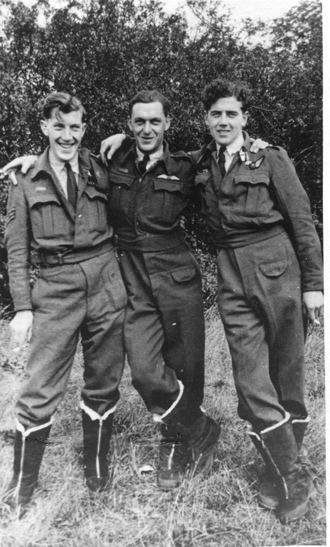
Don Pierce (Flight Engineer), Robert Watts (Pilot) and Bob Hogg (Bomb Aimer).
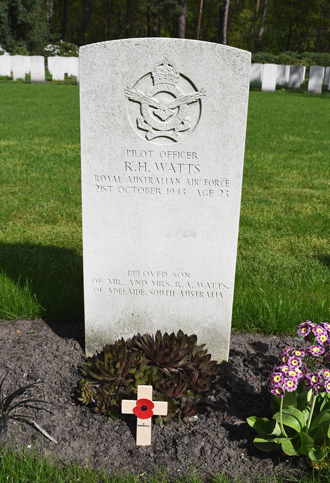
Robert Watts' headstone in the CWGC Canadian cemetery at Bergen-Op-Zoom.
